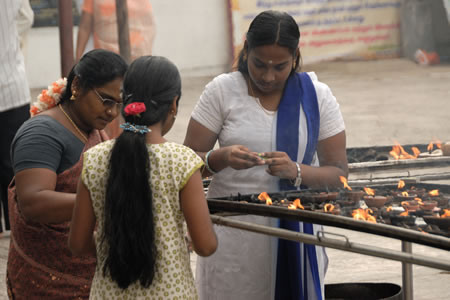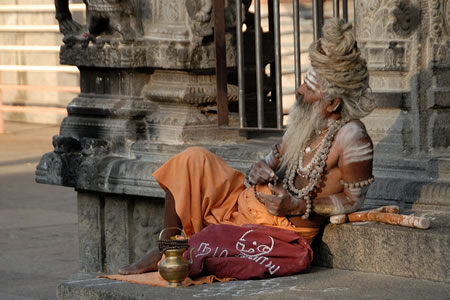English | Dutch |
|
| The most southern point of India | |
Bangkok (Thailand) to Kanyakumari (India), February 2012 |
|
After a week in both Bangkok and Kuala Lumpur, we flew on February 9th from the Malaysian capital city to Chennai in South India. It was the real start of the fourth stage of our journey. It was also the beginning of our fourth visit to India since we left for our journey in 2007. We saw most parts of India, but in the south we missed some places that we really wanted to see. So here we are again. But after this visit, which probably ends at the end of June and after which we spent almost a year in India, it is probably enough for a while. So we started our fourth visit in Chennai, formerly known as Madras and the fourth largest city in the country, after Mumbai, Kolkata and Delhi. Chennai made a very friendly impression on us. We spent several days in the city, and got a good notion of the metropolis. Many of the 6.6 million souls who live in this city have a miserable life. The city is poor, chaotic and dirty. There are many slums and large groups of people live a disgraceful existence. But most disturbing is the fact that there is no visible progression. Already for a decade people see India as one of the main global economic tigers that makes its appearance on the world economic stage. But progress is not visible in Chennai specifically and in India in general. No nice roads, no shiny buildings, no clean and efficient railway stations, ATM’s that are often out of order, polluting buses from the 70s, shitting people on the streets and garbage everywhere. It is really unbelievable that after so many years of economic progress, the country is still in many ways a disaster. The economic progress probably found its way to the pockets of the happy few. A leading Indian newspaper mentioned last week that most of the ‘secret’ Swiss bank accounts belong to Indian nationals. Nation Building is something India is not ready for yet. See also our photo impression about Chennai. |
|
 |
|
Burning candles in a temple in Chennai |
|
| After Chennai, we took the bus to the city Tiruvannamalai. Tiruvannamalai is one of the five elementary Shiva-cities. Here, Shiva is worshipped in his fire incarnation. We stayed in a small hotel near the main entrance of the temple and spent one of the days of our visit to walk the 14 kilometres pilgrimage around the holy Arunachala Mountain. It is still winter in south India, which means that the temperature doesn’t exceed the 30 degrees Celsius yet. This is what they call cool weather! De next destination on our way further south was another temple town: Trichy. The real present name for the city is Tiruchirappalli, but to prevent breaking the tongue over this complex city name, most people still use the old colonial name Trichy. Bus loads of Indian pilgrims visit the city everyday which gives it a nice atmosphere. The temples are beautiful, but as often with Hindu temples in the south, the real holy parts of the temples are not accessible for non-Hindus. See also our photo-impression of Trichy.
South India also has so-called hill stations. These places in the mountains are a popular retreat for people who want to escape the heat on the plains. Already in the colonial times, British rulers spent considerable times here to prevent getting boiled in the low lands. We decided to visit the small town of Kodaikanal, on around 2100 metres above sea level. During the day it was around 16 degrees Celsius and at night the mercury dropped to 6 or 7 degrees above freezing. We needed some extra blankets on our bed and most domestic tourists spent a few Rupees for an earmuff, which was a little bit exaggerated was our opinion. We did some hiking and birding in the green and lush area and after we looked forward to warmer weather again, we took the four hours bus ride to Madurai, probably the most famous temple city in southern India. Madurai is again a chaotic city, lots of pollution, but a great temple. The only disappointment was the fact that there is more tourist related hassle than in many other cities. Significant numbers of local men try to sell themselves as a guide, were tailors or try to earn some Rupees from tourists in another way. So, Madurai is a beautiful temple city, but with a less impressing experience. At least, that is our impression. |
|
 |
|
A charactaristic Sadhu (holy man) in Tiruvannamalai |
|
It was another 6 hours by local bus before we reached the most southern tip of this immense country. Kanyakumari, or Cape Comorin as the British called the place when they still ruled the country, is the place where India ends. The little town is nothing special, but people come here to be on this most southern tip of the country. There is of course a temple, but the domestic tourists mainly come here to see three oceans mingle. Don’t ask us which oceans these are. The local government tries to transform this former fishing village in what they call a mega tourism destination. They invested in a memorial for a Swami (sort of a Hindu monk) on a small island a couple of hundred metres off shore, built a view tower to see the oceans mingle and are working on turtle speed to make some kind of a boulevard. We know that it has to become a boulevard because it is mentioned on huge billboards, that, by the way, also mention that the project should have been finished at the end of 2010. More than a year behind scheduled due date is nothing special in India. They probably need a couple of years more. But the delay is surely not the result of inferior building equipment. For the first time we see ‘state of the art’ Volvo Bulldozers and German MAN trucks. But if you see subsequently that the guys that should be working with these machines are sleeping in the air-conditioned cabins, you realise where things go wrong. “Good building equipment is half the work” is what they probably thought. Now all they have to do is to find a solution for the second half of the problem.
|
|
| <Previous weblog> | |